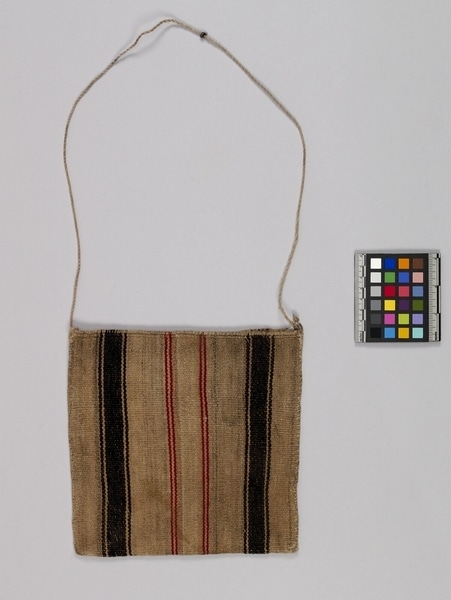Bag Item Number: Sf985 from the MOA: University of British Columbia

Description
Rectangular bag with vertical stripes and cord handle constructed from one, four selvedge piece of warp-faced fabric. Wide black stripes flanked by narrow ones are near the edges and two pairs of narrow red stripes are centrally placed on a background of light brown. The side seams are overcast and the bag mouth is reinforced with overcastting.
History Of Use
Warp-faced fabrics with three or four selvedges are woven by women on the indigenous style loom, a staked-out horizontal ground loom, or an adjustable tension (body) loom. The technique and structure have pre-Conquest antecedents, and as in ancient times, the fabrics are used in their rectangular form without cutting or shaping. This is a very traditional bag form throughout the Andes extending back to ancient times. It is frequently used for carrying seeds during planting. Children also use it for carrying books or food to school.
Cultural Context
Children; everyday.
Specific Techniques
Plain colour areas or stripes are warp-faced plain weave.
Narrative
Made by Josepha Huatta Yucra and used by her children for carrying food and notebooks to school. The inside of the bag was encrusted with parched flour or grain.
Item History
- Made by Josepha Huatta Yucra (Maker) in Taquile, Puno, Peru during 1979
- Collected by Elizabeth L. Johnson during 1984
- Owned by Gonzalo Yucra Huatta, Valeria Yucra Huatta and Eufrasia Yucra Huatta
- Owned by Elizabeth L. Johnson before June 13, 1984
- Received from Elizabeth L. Johnson (Seller) and Museum of Anthropology Shop Volunteers (Funding source) on June 13, 1984
What
Who
- Culture
- Quechua
- Creator
- Josepha Huatta Yucra (Maker)
- Field Collector
- Elizabeth L. Johnson
- Previous Owner
- Gonzalo Yucra Huatta, Valeria Yucra Huatta, Eufrasia Yucra Huatta and Elizabeth L. Johnson
- Received from
- Elizabeth L. Johnson (Seller) and Museum of Anthropology Shop Volunteers (Funding source)
Where
- Holding Institution
- MOA: University of British Columbia
- Made in
- Taquile, Puno, Peru
When
- Creation Date
- during 1979
- Collection Date
- during 1984
- Ownership Date
- before June 13, 1984
- Acquisition Date
- on June 13, 1984
Other
- Item Classes
- textiles
- Condition
- good
- Accession Number
- 0992/0013